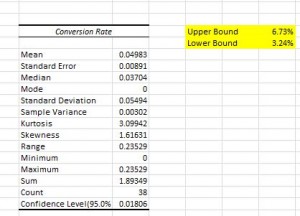Imagine you are an digital marketer driving a campaign to your company website. Next month you are adding new media to your current marketing mix and your C-level executive asks “What kind of conversion rate should we expect with the addition of new media?’
Executive Focus
Executives only focus on Return on Investment (ROI), or Return on Marketing Investment (ROMI). These are the questions their bosses or shareholders will ask. They have no interest in details or understanding exactly what is happening online, it’s all about money.
Internet Marketer’s Focus
This person has been diligent about collecting data for the campaign and monitoring it for conversion. They have spent countless hours making sure that the media mix is converting the goals they have set out for the campaign. The marketer has done their job researching new opportunities to add to the media mix, but the question the C-level executive has posed is unfair.
Why is “what kind of conversion rate should we expect with the addition of new media” an unfair question.
- The marketer only has research for the new media and not exact conversions. (Keep in mind that the research is usually from a 3rd party or a survey)
- There may not be any historical data for the new media partners
- The digital marketer isn’t trained to create a model that will project the conversion rate
- There is no time to create a projection model
Two Data Driven Solutions
- Confidence interval for conversion rates
- Engagement metrics that lead to conversion
Confidence Interval for Conversion Rates Solution
 The digital marketing confidence interval is a statistical formula that derives the upper bound, and lower bound conversion rate. The goal is to state that your conversion rate should be between X and Y with a 95% confidence level. If the conversion rate is below this range, then your digital marketing team needs to figure out what aspects of media are not converting and remove that media from the digital marketing mix.
The digital marketing confidence interval is a statistical formula that derives the upper bound, and lower bound conversion rate. The goal is to state that your conversion rate should be between X and Y with a 95% confidence level. If the conversion rate is below this range, then your digital marketing team needs to figure out what aspects of media are not converting and remove that media from the digital marketing mix.
The advantage of this method is the range of conversion based on historical data. This also allows some time for the new media to take into affect. Most importantly, it does not corner the digital marketer into an exact number. This flexibility is important as sometimes new media advertisements take time to resonate.
Engagement metrics that lead to conversion
In digital marketing campaigns, it is very important to capture engagement metrics. Our campaign measurement strategy always revolves around all engagement metrics that lead to conversion. If engagement metrics are low, there is little chance for conversion. This allows your team to optimize your digital media mix.
Conclusion
Executives often ask complicated questions. In many situations, exact answers can put you in an uncomfortable spot with your digital planning. We truly believe that optimizing campaigns is more important than providing an exact number. This method is always striving to optimize media and websites for better conversion.
Related posts: Measuring KPIs, Quality Insights, Why use custom floodlight tags in digital campaigns